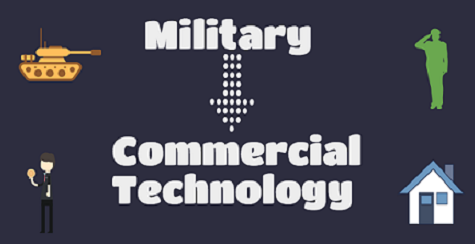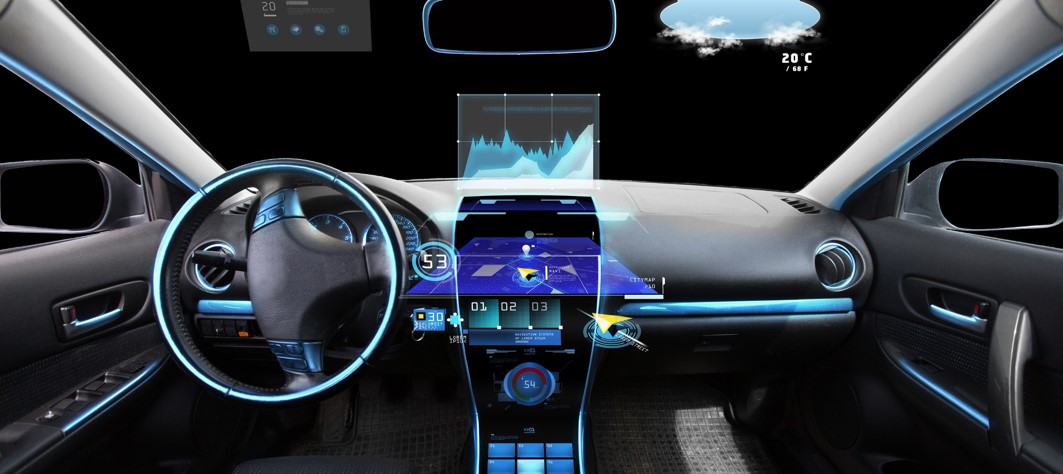What do a computer, a microwave, and duct tape have in common? All of these now indispensible items were originally developed for war. Military technology often has widespread applications for civilian life, and thus, it is not uncommon to see the transition from military to commercial use.
Though war is no doubt ugly, the high stakes can propel technology forward to accomplish unimaginable feats. Some of the most important technology today was developed not because of desire, but because of necessity. Money, too, is a key reason why major tech breakthroughs occur in the military. With a $637 billion defense budget each year, the United States is able to allot approximately $63.3 billion a year on research, development, and testing. This large sum makes it possible to turn theories into products quickly, whereas low budget inventors may take years to accomplish the same thing. In fact, many military technologies were created when the defense establishment decided to take on projects that had been initiated decades earlier, but never had the proper funding or attention to actualize.

Drones: 1917/1960s
The drone was first built out of wood and tin in 1917 by a military scientist who believed he had invented a new way to help England win World War I. Designed to be an aerial torpedo that could deliver bombs via remote control, this primitive drone set the way for a new military technology that would alter the course of warfare. The technology is now often associated with the controversial CIA drone strikes used in the Middle East.
It was not until the 1960s that drones became a tool of commercial importance, when it was discovered that they could be used for atmospheric research, or even to generate electric power. Today, the growing drone market includes uses as far ranging as law enforcement, land surveying, weather forecasting, and search and rescue. Most recently, Amazon patented a new plan to use drones for package delivery, a radical new method that will allow customers to receive their orders within 30 minutes!
Radar: 1930/1946
The late 19th century discovery that solid objects can reflect radio waves set the development of modern day radar in motion. Though numerous attempts were made to transform this knowledge into a working detection system, radar did not become a reality until the mid 1930s, when eight countries separately and secretly developed radar systems that would be used in World War II. It was initially used to locate and target enemy ships and planes, increasing both the efficiency and the deadliness of war. In 1946, Percy Spencer realized that the same radar technology could be used to heat food, and the microwave was born. With obvious commercial implications for the previously military product, radar jumped the gap to become widely used in any average household.
Jet Engine: 1940/1960s
Modern day air travel would not be possible without the jet engine, whose jet propulsion technology allows planes to travel long distances. The first jet engine powered aircraft, called the Heinkel He 178 V1, was tested in Germany in 1939 in extreme secrecy. The German military continued to develop the jet, and was closely followed by the British introduction of the same technology. While first produced primarily for combat aircraft, the jet engine could be found on all civilian aircraft by the 1960s. In addition to use in air travel, jet engines also power gas turbines and water and oil pumps. The invention has become so widespread, that it has even become synonymous with the word airplane, which many people simply call a jet.
Duct Tape: 1942/1945
During World War II, the US needed a waterproof tape to keep moisture out of ammunition cases. Known for its long history of producing adhesive materials, Johnson and Johnson was enlisted to develop such a product for the military. What emerged was the cloth-based tape we know today as duct tape, or “duck” tape because of its waterproof characteristics. From repairing airplane wings and tanks, this military technology eventually proved useful for fixing just about anything! Soldiers would use it to repair their clothes, or even make new ones, and it became a staple in heating and air conditioning duct work. Now, duct tape can be found in any hardware store and most households.
Nuclear Energy: 1942/1954
In December 1942, nuclear power became a reality. Funded by the United States army, the Manhattan Project created the first nuclear reactor capable of enriching Uranium for use in a nuclear weapon. The most immediate consequence of this invention, aside from making the U.S. the first nuclear power, was the death of over 100,000 people in Hiroshima, the first city to ever be targeted by a nuclear weapon. However, despite the obvious destructive powers of this weapon, nuclear energy also had the potential to be used to power electricity. The first nuclear power plant was established in 1954 in the Soviet Union. Though shrouded in controversy, the advent of nuclear energy has been significant for many countries, including the U.S., where 99 commercial reactors produce nuclear energy today.
Computer: 1944/1951
Arguably the most important technological development of the last century was the invention of the computer. Faced with previously unmatched German encryption machine Enigma in World War II, the British army set out to create a device that would be able to break the German codes consistently. The first successful solution, and electromechanical device called the Bombe, was invented by Alan Turing in 1939. Turing’s design contributed to the world’s first electronic digital programmable computer, Colossus, which finally allowed the British to intercept and decrypt a German message in 1944. Computers turned commercial in 1951 and became popular when the U.S. Census Bureau began to use the UNIVAC I, a machine that cost approximately $1 million and took up 943 cubic feet. Since, then, computers have gotten progressively smaller and cheaper and now number in the billions worldwide.
Satellite: 1957/1962
Satellites arose as a result of the Cold War-era Space Race between the United States and the Soviet Union. The successful of the Soviet Sputnik in 1957 was not only a crucial political event, but also the beginning of the development of satellite technology. The military began to use reconnaissance satellites to carry out intelligence gathering, military communications, and missile detection. Since then, satellites have been extended to a wide range of civilian uses, from the communications satellites that are responsible for our TV, Internet, and telephone, to the weather satellites that are able to monitor and predict (occasionally accurately) the earth’s climate.
Internet: 1969/1986
If the computer is the body, the Internet is the brain that makes sophisticated connections possible. In 1962, the Department of Defense Advanced Research Projects Agency set out to create a system that would allow the military’s computers to connect and communicate. Aside from the practical application of this capability, the Department of Defense aimed to develop a secure and reliable communication network that could function through a nuclear attack. The result came to be known as ARPANET, and was the direct precursor to the modern Internet. The transition occurred over a span of about 20 years, in which scientists and researchers expanded the sophistication and geographic reach and invented the Domain Name System – the official name for .com. Today, over 3 billion users are connected to the Internet, a technologically that literally connected the world and in doing so, changed it invaluably.
GPS: 1978/1983
The now ubiquitous GPS technology has its roots in the Cold War, when American scientists discovered that they could locate the Soviet satellite Sputnik through its radio transmissions. The United States Army, Navy, and Air Force seized on this realization and began rapidly developing the technology in order to maintain a military edge in its ballistic missiles and radio-navigation systems. What eventually emerged in 1978 was a Pentagon-run global positioning system of 24 satellites, to be used for defense purposes.
The shift from purely military to commercial use came in 1983 when, after a U.S. civilian plane went off course and was shot down in Soviet airspace, President Reagan issued a presidential directive opening GPS channels to civilians. Suddenly, this technology was being used to improve the lives it was developed to save. Now, the uses of GPS have expanded beyond simple location services, and have come to be the basis for many tech industries. Social networking apps, advertisement technology, games, and fitness apps can all use GPS technology to make their services possible and efficient.
Command and Control Center: 2011/2015

But the success of mPrest’s system is not limited to times and regions of war; mPrest is now applying the command and control software to utilities systems all over the world and can be applied to water, oil and electric systems alike! The software allows for coordination between hardware and software components used in utility generation and optimizes output efficiently. When fitted to an electric grid, the software can identify failing transformers and redirect power efficiently. Lastly, it strengthens the grid against cyber attacks by detecting viruses immediately and diverting electric flow from affected areas, preventing the malware from spreading. By preventing power outages that plague even the most advanced cities, mPrest has the potential to save money, manpower, and time.
mPrest’s command and control center software is now joining the list of military technologies that have become major players in the commercial sphere. As a crucial path that a product can take to ultimately reach the public market, the military to civilian transition shows the versatility of many innovations that can be adapted to fit numerous purposes. The winners in this process are not only the companies that profit from two distinct industries, but also people around the world who benefit from having these technologies in their lives.








